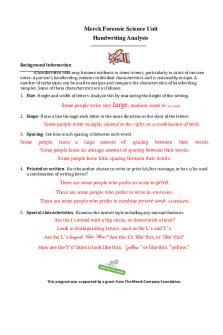Unit 5 Essay - Handwriting Characteristics PDF

| Title | Unit 5 Essay - Handwriting Characteristics |
|---|---|
| Course | Forensic Science I |
| Institution | Post University |
| Pages | 3 |
| File Size | 58.7 KB |
| File Type | |
| Total Downloads | 91 |
| Total Views | 143 |
Summary
Essay on the characteristics of handwriting...
Description
1 Unit 5 Essay Prompt 1: Discuss the variations in handwriting that lead to individual characteristics.
All of us are taught to read and write at some point in our lives, it’s simply another way of communication that doesn’t require talking. Just like fingerprints, there are no two people that have the same exact handwriting although characteristics may be similar. When each of us first learn to write we are taught by copying a sample or mimicking whomever is teaching us. This is why when we are younger or just learning to write, a lot of our handwriting styles may appear similar. However, as we grow up we stop associating writing with copying and more with putting thoughts onto paper “as initial writing skills improve, a child normally reaches the stage where the nerve and motor responses associated with the act of writing become subconscious. The individual’s writing now begins to take on innumerable habitual shapes and patterns that distinguish it from all others.” (Saferstein, 2018). These individual characteristics include angularity, slope, speed, pressure, letter and word spacings, relative dimensions of letters, connections, pen movement, writing skill, and finger dexterity. Another important aspect the analyst will pay attention to is the arrangement of words on the document in question. Margins, spacings, crowding, insertions, and alignment are all results of personal habits. Spelling, punctuation, phraseology, and grammar can be personal and, if so, combine to individualize the writer.
Prompt 2: Discuss the differences between visible and latent computer data.
Visible data can be defined as all data that the operating system is presently aware of and thus is readily accessible to the user. Data/work product files are categorized under visible data,
2 Unit 5 Essay generally this means any files that come from computer software such as Microsoft Office or even QuickBooks. Investigators work hard to familiarize themselves with these programs in order to successfully retrieve any digital evidence that may be useful to a criminal case. Swap file data (a file or defined space on the HDD used to converge RAM) and temporary files (files temporarily written by an application to perform a function or to provide a “backup” copy of a work product should the computer experience a catastrophic failure) are also included under visible data that investigators may use as evidence in a case. Latent data can be defined as areas of files and disks that are typically not apparent to the computer user (and often not to the operating system) but contain data, nonetheless. To view latent data, the investigator must create a forensic image, or detailed copy of the computer in question. Making sure to get every bit of data is extremely important as investigators don’t want to leave any valuable pieces of evidence out of the equation.
3 Unit 5 Essay Reference Saferstein, R. (2018). Introduction. In Criminalistics: An Introduction to Forensic Science(12th ed., p. 12)....
Similar Free PDFs

Unit 5 Essay - Discussion
- 3 Pages

Handwriting Worksheet
- 3 Pages

Unit 5
- 9 Pages

Unit 4 essay immigration
- 4 Pages

Unit 6 Essay
- 4 Pages

Nematodes Characteristics
- 3 Pages

Learning Journal Unit 5
- 2 Pages

Assignment Unit 5
- 6 Pages
Popular Institutions
- Tinajero National High School - Annex
- Politeknik Caltex Riau
- Yokohama City University
- SGT University
- University of Al-Qadisiyah
- Divine Word College of Vigan
- Techniek College Rotterdam
- Universidade de Santiago
- Universiti Teknologi MARA Cawangan Johor Kampus Pasir Gudang
- Poltekkes Kemenkes Yogyakarta
- Baguio City National High School
- Colegio san marcos
- preparatoria uno
- Centro de Bachillerato Tecnológico Industrial y de Servicios No. 107
- Dalian Maritime University
- Quang Trung Secondary School
- Colegio Tecnológico en Informática
- Corporación Regional de Educación Superior
- Grupo CEDVA
- Dar Al Uloom University
- Centro de Estudios Preuniversitarios de la Universidad Nacional de Ingeniería
- 上智大学
- Aakash International School, Nuna Majara
- San Felipe Neri Catholic School
- Kang Chiao International School - New Taipei City
- Misamis Occidental National High School
- Institución Educativa Escuela Normal Juan Ladrilleros
- Kolehiyo ng Pantukan
- Batanes State College
- Instituto Continental
- Sekolah Menengah Kejuruan Kesehatan Kaltara (Tarakan)
- Colegio de La Inmaculada Concepcion - Cebu







